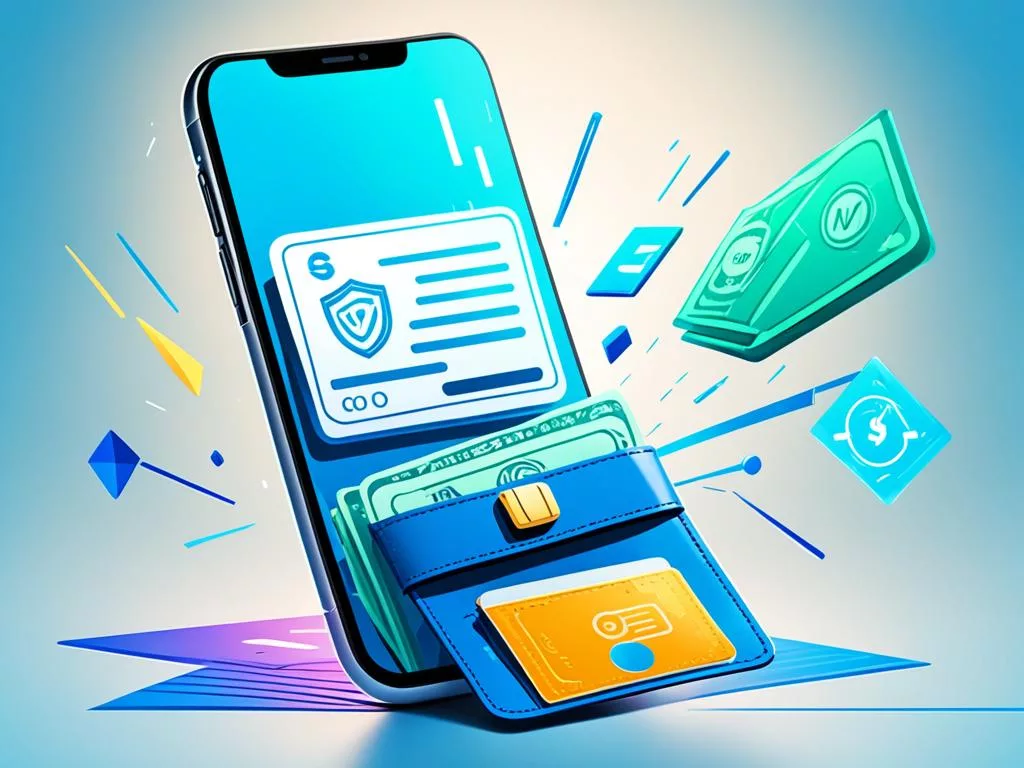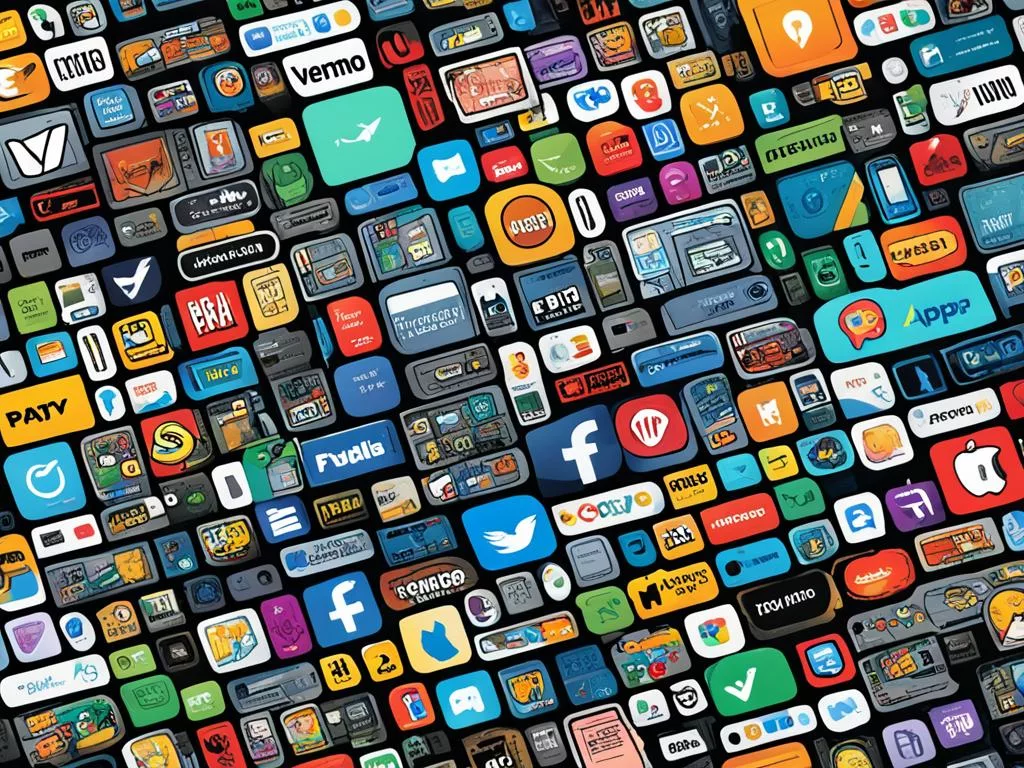Mobile wallets like Google Pay, Apple Pay, and Samsung Pay bring secure and fast payments. They make it easy to pay without touching anything, which is very handy1. Using mobile wallets means you can pay quickly at many places, like stores and in taxis. They make you rethink the need for a physical wallet1. Plus, adding different cards, even membership and gift cards, is easy. This makes shopping simpler because all payments are just a tap away with your phone1.
The launch of Apple Pay in 2014 marked a huge step in digital wallets2. Apple Pay, Google Pay for online and in-store buys, and Samsung Pay’s MST for old terminals, all changed the game2. These services keep your card info safe. For instance, Apple Pay doesn’t store your card numbers and encrypts your transactions. This way, your financial info stays private3.
Secure payments are getting even better with potential crypto use and biometrics2. This tech suits my digital lifestyle well. It’s about the synergy between fintech and traditional finance sectors. Together, they’re improving how we handle money digitally2.
Decoding the Technology Behind Mobile Wallets
I’ve seen how we’ve moved to digital payments, and why mobile wallets are key. The market for cryptocurrencies, now over $1 trillion4, shows just part of this change. Near Field Communication (NFC) lets people pay without touching, by tapping their phone at the checkout. Security is tight, thanks to tokenization. This means your real card details stay hidden. Instead, a one-time encrypted token is used.
QR codes also make paying easier, by showing payment info as something you can scan. Host Card Emulation (HCE) lets a phone act like a card on NFC devices, without needing extra secure storage. And with biometric checks, like fingerprints, transactions are even safer.

Let’s dive deeper into mobile wallets, especially with cryptocurrency getting popular. The IRS now treats cryptocurrency as property, so it’s taxed4. This makes security in mobile wallet tech even more important. Angelica Montanez at Marshall University has found ways to see how crypto wallets leave marks on mobile devices5. This helps trace illegal transactions back to the devices used5.
The way we use mobile wallets is changing, but it’s not always easy. Studies are looking at how to get wallet data from iOS systems5. Every discovery shows how mobile wallets help make our money matters easier and safer.
Step-by-Step Guide to Mobile Wallets
Mobile wallets are becoming crucial because they allow you to pay without physical cash. We’ll explore how to use different mobile wallets. This includes Apple Pay, Google Wallet, and Samsung Pay. This tech is not just popular; it’s changing the way we spend money. With 43.9% of mobile market shares in the US6 and 62% of Americans thinking we’ll soon live without cash6, it’s important to learn how to use these apps. We’ll start by setting up your mobile wallet.

- Find the pre-installed mobile wallet app on your smartphone. With Apple Pay, Google Pay, and Samsung Pay ranking among the most popular digital wallets7, most devices come with one of these apps already installed.
- Access the app and look for the “+” sign to add a new card.
- Follow the on-screen prompts which may include entering your card details manually or scanning your card with the device’s camera.
- After your card information is entered, it undergoes encryption and tokenization for secure storage within the digital wallet, offering more security layers than physical card payments7.
By setting up your wallet, you join the 89% of Americans using digital payments7. Digital wallets offer great convenience7. But sometimes, you might find places that don’t take mobile payments. Always look for signs that they accept contactless payments. Despite most people moving to digital wallets soon7, remember there can be challenges like your phone’s battery dying or stores not accepting digital payments7.
| Mobile Wallet | Market Share | Active Users | Security Features |
|---|---|---|---|
| Apple Pay | 43.9% in the US6 | Not Disclosed | Encryption, Tokenization |
| Google Pay | Global Market | 150 Million6 | Encryption, Multi-layered Security |
| Samsung Pay | Expanding Reach | 16.3 Million6 | Encryption, Tokenization, Samsung Knox |
In conclusion, using mobile wallets like Apple Pay, Google Pay, and Samsung Pay is a smart move. They’re safer than carrying cash or cards and are used by millions globally67. As we move closer to a cashless future, knowing how to use these apps keeps you ahead financially.
Mobile Wallet Comparison: Finding the Best Fit for Your Needs
In the world of mobile payments, I compare the top mobile wallet apps. I examine how they match up to our everyday needs. The popularity of tapping to pay is expected to jump by 150% by 20288. We all want our digital payments to be smooth and easy to use.
I find that security and ease of use are key. Google Pay, with a 4.5 rating, meets these needs for Android users. It even gives special numbers to keep your info safe9.
Exploring different mobile wallets shows me how varied they are. Cash App is simple and gets a 4.0 rating. It makes buying stocks and Bitcoin easy. Zelle allows you to transfer money between banks fast, earning a similar rating9. Apple Pay and Samsung Pay both have a 3.5 rating. Apple Pay is great for iPhone users, offering a special virtual card. Samsung Pay works almost everywhere and has a rewards program9. Choosing the right service depends on your daily life.
Payment apps are now common in stores and online. This change shapes what we expect from shopping. After COVID-19, more people want to pay without touching cash or cards98. It’s important to choose a service that keeps your data safe. With top-level encryption, many apps are safer than traditional cards8. Venmo, rated 3.0, is great for friends but keep an eye on your privacy settings. Being able to erase your data from lost devices is a big plus for safety98.
My study shows finding the best app isn’t just about features. It’s about finding a safe, compatible way to manage your money.
Source Links
- https://www.abt.bank/unlock-your-mobile-wallet-secure-contactless-payment-solutions/
- https://www.slideshare.net/slideshow/digital-wallets-a-comprehensive-guide-to-secure-and-convenient-transactions-enterprise-wired/266616829
- https://support.apple.com/en-us/101554
- https://www.taxnotes.com/lr/resolve/tax-notes-federal/decoding-cryptocurrency-taxes-the-challenges-for-estate-planners/7j415
- https://www.marshall.edu/forensics/files/Montanez-Angelica_Final-Research-Paper.pdf
- https://www.nationalmerchants.com/using-digital-wallets-a-how-to-guide/
- https://www.bankrate.com/banking/what-is-a-digital-wallet/
- https://www.cnet.com/personal-finance/banking/advice/best-digital-wallets-payment-apps/
- https://www.pcmag.com/picks/the-best-mobile-payment-apps

